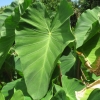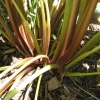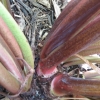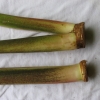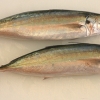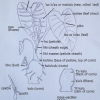Use As Food
Sparingly as a table taro. The taro has excellent quality as table taro. The Mana and the Lauloa taros are used in preference to all others for making the Hawaiian pudding kūlolo, a combination of grated taro and coconut milk.
Distribution
Planted in a few scattered localities on Hawai‘i and Maui, nearly always under upland, dryland culture (māla).
General Characteristics
Medium in height, erect, moderately stocky, maturing within 7 to 12 months, producing two or three branches; distinguished by the yellow ‘i‘o kalo (Corm) flesh and heavy reddish-brown flecking on the lower portion of the hā (Petiole).
Ha (Petiole)
60 to 90 cm. long, pale green prominently flecked with reddish- brown to purplish on the lower portion, with fairly distinct broad pinkish edge, pale pink at kōhina (base) with a white ring.
Lau or Lu'au(Leaf Blade)
20 to 50 cm, long, 20 to 30 cm. wide, 20 to 40 cm. from tip to base of sinus, arrow shaped head, chartaceous (paper like), dark green or with bluish cast; piko yellowish to reddish; round leaf section (lobes) acute with deep lihi māwae (sinus).
'I'o kalo (Corm)
Flesh yellow with yellowish fibers; skin cream-colored, occasionally purple along leaf-scar rings.
Pua (Flower)
Remarks
According to Hawaiian fishing practitioners, the fish bait was prepared by cooking and pounding the taro until it could be broken in small pieces. The pounded taro was placed in a small net beg and lowered into the water directly above a large net, previously laid. The taro was released from the bag by a sudden jerk of a cord, and as soon as the school of ‘ōpelu was within the large net, the net was hoisted to the surface.

